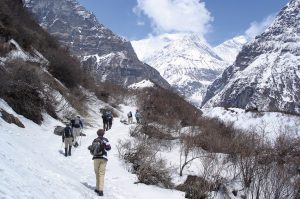The Nepali government has approved a two-day weekend beginning May 15. This is ostensibly to reduce the use of vehicles and fuel by civil servants in order cut fuel costs. The decision comes amidst talk of an economic crisis in Nepal, with some economists even describing the current financial situation as “alarming” and “a crisis.”
The economic and subsequent political crisis in Sri Lanka has heightened apprehensions in Nepal. Sri Lanka’s current financial crisis, the worst since 1948, when the country became independent, is due to a massive balance of payment (BoP) deficit and a shortage of foreign currency. Sri Lanka’s economy, which is dependent on tourism, suffered a major blow with the COVID-19 lockdowns, leading to its foreign exchange crisis. As a result, it could not import vital necessities, including food and fuel. Inflation has soared, and people are on the streets protesting.
Nepal’s vital economic signs are not very promising. During the first eight months of the current fiscal year 2021-22, imports increased by 38.6 percent to $10.7 billion. However, exports totaled $1.2 billion, resulting in a total trade deficit of $9.5 billion, accounting for almost 28 percent of Nepal’s GDP in 2021. The current account deficit also increased from $1.29 billion to $3.88 billion. Nepal finances the current account deficit primarily by trade credit, external concessional loans, and reserve drawdowns. Its export is boosted by palm oil and soybean oil imported from third countries and exported to India, taking advantage of zero tariffs. Should India ban the imports of these items from Nepal, as it did temporarily in the past, Nepal’s export situation would be bleaker.
Equally concerning for Nepal is the reduction in the flow of foreign remittances. Remittances account for more than a quarter of Nepal’s GDP. During the early stages of the pandemic, remittances increased despite expectations to the contrary. However, in the first eight months of the current fiscal year, remittances declined by 1.7 percent to $5.2 billion.
As a result, Nepal’s gross foreign exchange reserves decreased to $9.58 billion from $11.75 billion. As a result, its foreign exchange reserves are sufficient to cover prospective merchandise and services imports for just 6-7 months.
Despite this, the government has remained bullish.
During a parliamentary finance committee meeting in December, Finance Minister Janardan Sharma expressed confidence that conditions were favorable for achieving the targeted 7 percent growth this year. However, even his lieutenants in the government disagree. “Hyped consumer demand, supply chain management chaos, hoarding, hyper credit, rising inflation: bullwhip!!!” Finance Secretary Madhu Kumar Marasini tweeted. The World Bank estimates the country’s economy to grow by 3.7 percent in 2021-22, and 4.1 percent in 2022-23.
Yet, alarmed by the developments in Sri Lanka and the worsening economic scenario in Nepal, the government and Central Bank have taken some preventive measures. On April 26, the government formally banned the import of 10 luxury or non-essential goods till mid-July 2022. The decision was preceded by a verbal direction from the Central Bank discouraging traders from opening letters of credit to import non-essential goods.
The Central Bank also requires importers to keep a 100 percent margin to open a letter of credit to import alcoholic drinks, tobacco, silver, furniture, sugar, instant foods, cosmetics, and construction materials. Similarly, importers have been told to keep a 50 percent margin for motorbikes and diesel-powered private automobiles.
The suspension of Central Bank Governor Maha Prasad Adhikari has added to the clutter as well. In early April, the government set up a committee to probe allegations that Adhikari had leaked sensitive information and was not fulfilling his responsibilities effectively. Insiders believe that souring relations between Adhikari, an appointee of former prime minister Khadga Prasad Sharma Oli and the present government contributed to his suspension.
With the Supreme Court reinstating Adhikari as Central Bank governor, Nepal is in a difficult situation, in which the finance minister and the governor of the Central Bank do not see eye to eye. This could not have come at a worse time.
Nepal’s economic situation is nowhere close to Sri Lanka’s, despite trends to the contrary. Firstly, Nepal does not depend upon tourism as much as Sri Lanka. Besides, it removed all pre-arrival testing requirements for fully vaccinated travelers and this has contributed to tourism rebounding.
Secondly, foreign remittances are expected to increase soon. The number of Nepali workers taking approval for foreign employment or renewing their permits has increased significantly in recent months. The increase in oil prices, which increased Nepal’s import costs (gasoline forms about 12 percent of Nepal’s total imports), is also likely to increase the demand for workers in the Gulf Cooperation Council countries.
Thirdly, Nepal’s debt to GDP ratio still is below 50 percent despite the increase in debt during the pandemic. And finally, Nepal’s currency is pegged to the Indian currency. This should prevent the free fall of the Nepali currency against the U.S. dollar in the short term.
However, Nepal shares some long-term problems that have dogged Sri Lanka, which contributed to the crisis on the island. Nepotism, crony capitalism, corruption, and incompetence are widespread in Nepal, as they are in Sri Lanka. Without due diligence and cost-benefit analysis, leaders are promised large projects, such as the trans-Himalayan railway.
Any additional external shock or significant decline in remittances will spell substantial trouble for an unstable economy looking to return to normalcy.

































